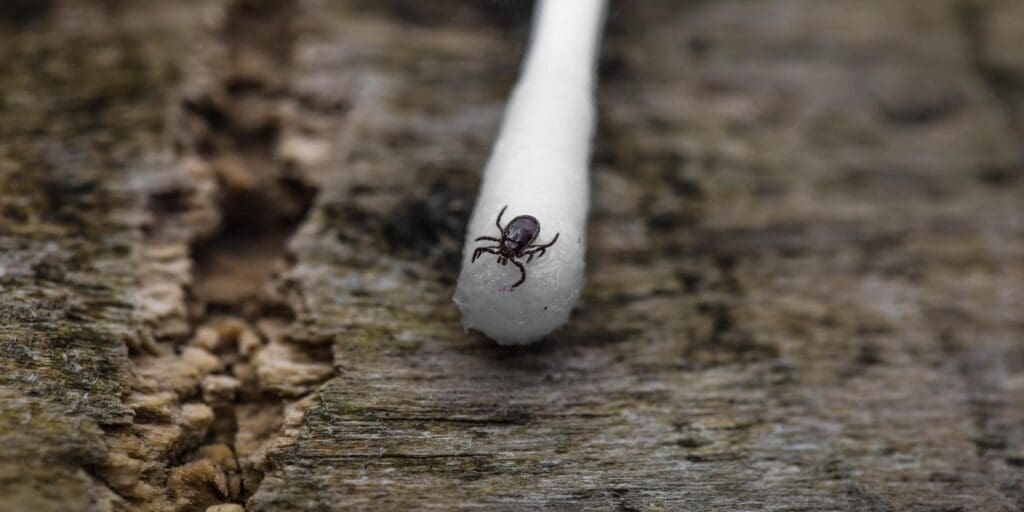According to the Connecticut Department of Public Health, this year’s first reported deadly case of the Powassan virus has been confirmed. According to Connecticut DPH, the woman was in her 90s when she first became infected with the virus. After being admitted to the hospital, records say she displayed symptoms including fever, altered mental status, headache, chills, rigors, chest pain, and nausea. Officials say her condition soon worsened and she became unresponsive, and would later pass away on May 17.
DPH officials say the woman did have a known tick bite that was removed two weeks before her symptoms. Laboratory tests confirmed the presence of Powassan virus.
“This incident reminds us that residents need to take actions to prevent tick bites now through the late fall,” said DPH Commissioner Dr. Manisha Juthani. “DPH stresses the use of insect repellent this summer and avoiding high-risk areas, such as tall grass, where ticks may be found. It’s also important to check carefully for ticks after being outside which can reduce the chance of you and your family members being infected with this dangerous virus.”
Tickborne illnesses, like the Powassan virus, can be extremely dangerous, which is why it’s important to understand how to protect yourself. In this article, we’ll cover everything you need to know about the Powassan virus, and how you can better protect yourself while spending time outdoors this summer.
What Is Powassan Virus?
Powassan virus is a tickborne flavivirus (a type of RNA virus) that is related to some mosquitoborne viruses like West Nile virus. The virus is named after Powassan, Ontario where it was first discovered in 1958.
Since its discovery, two types of Powassan virus have been identified in North America. These include lineage 1 and lineage 2 Powassan viruses. Traditionally, Powassan virus is extremely rare in the United States, although the number of reported cases of people sick with the virus has increased in recent years, according to the Centers for Disease Control and Prevention (CDC).
Most cases of Powassan virus occur in the Northeast and Great Lakes regions and are most commonly reported in late spring through early fall when ticks are most active.
Currently, there are no vaccines or medications that are known to help prevent or treat Powassan virus.
How Do You Get Powassan Virus?

As previously mentioned, Powassan virus is transmitted through the bite of an infected tick. Like many other tickborne diseases, like Alpha-gal or Lyme disease, not all ticks carry Powassan virus, and not all people bitten by a tick will contract the virus. A tick needs to be attached to a person for a certain amount of time before it can transmit the virus. Unfortunately, this time interval is not known for Powassan virus, but it is likely shorter than 12-24 hours.
The blacklegged tick, also known as a deer tick, is known to carry lineage 2 type Powassan virus. This is the same type of tick that spreads Lyme disease, anaplasmosis, and babesiosis. In the United States, deer ticks are usually found in heavily wooded areas in the Northeastern and upper Midwestern states. In most of these states, the months of April through July and September through October are the greatest risk of being bitten by a deer tick.
The other type of Powassan virus, lineage 1, is carried by two similar tick species, often referred to as groundhog and squirrel ticks, which usually feed on smaller animals instead of humans. These ticks have also been found in wooded areas of the Northeast and Midwest, but humans rarely come into contact with them, so they are much less common transmitters of Powassan virus.
Tick bites can often go unnoticed, which is why it’s important to understand the signs and symptoms of viruses like Powassan and other tickborne illnesses. While cases of Powassan virus remain low, prevention and protection remain your best way to avoid becoming ill.
Symptoms of Powassan Virus
Many people who become infected with Powassan virus will have no symptoms. For those that do, symptoms typically appear within 1-4 weeks from a tick bite. Commonly reported symptoms of Powassan virus include:
- Fever
- Headache
- Vomiting
- Seizures
- Weakness
- Encephalitis (swelling of the brain)
- Meningitis (swelling of the membranes around the brain and spinal cord)
Patients with more severe cases of Powassan virus may experience more long-term symptoms such as chronic headaches and memory problems. In rare cases, like the one reported by Connecticut DPH, Powassan virus can be deadly (around 10% of cases with encephalitis).
What You Can Do to Prevent Powassan Virus


As mentioned by officials from Connecticut DPH, taking the necessary precautions when spending time outdoors, especially in areas where ticks are more common, is the best way to prevent tickborne illnesses like Powassan virus.
Preventing tick bites may sound easier said than done, but it’s not impossible. When spending time outdoors, use insect repellents, regularly check your body, and wash your clothing after you return home. Ticks are smart and will try to move to places on your body that are harder to see, such as behind your knees, under your armpits, or in your hair. This is why having a second pair of eyes is often helpful when checking for ticks.
Should you see a tick on you or your clothing, the first thing you should do is check to see if it has bitten you. If it hasn’t you don’t need to worry about Powassan virus or other tickborne viruses. In these instances, simply remove the tick, dispose of it, and ensure that you thoroughly check the rest of your body and clothing for others.
If you have been bitten, the longer that tick stays attached to you, the higher the likelihood of you contracting a disease like Powassan virus. To remove a tick safely, use a pair of clean, sanitized tweezers, get as close to your skin as possible, and grip the head of the tick. Pull straight away from your skin, ensuring that you do so without jerking or twisting. Once you’ve removed the tick, dispose of it, and check your body for others.
If you’ve been bitten by a tick, it’s not imperative that you call a doctor right away. If you’re worried about infection, or if you believe the tick may have been attached for a long period, take a picture of the tick and the bite area, and monitor your symptom over the following days or weeks. Should you start to develop any adverse symptoms, or if the bite area becomes sore or infected, it may be time to speak with a doctor.
When to See a Doctor
It’s not always clear as to when, or if, you should see a doctor regarding a tick bite. If you notice any symptoms that may be related to Powassan virus, you should talk with a doctor immediately.
More severe cases of Powassan virus are typically marked by a quicker onset and more aggressive symptoms. These may include headaches, high fever, confusion, tremors, seizures, paralysis, or coma. If you display any of these symptoms following a tick bite, you must seek medical attention immediately.
Powassan virus is diagnosed based on a patient’s clinical symptoms and tests of blood or spinal fluid. These tests usually detect antibodies that the immune system produces to help fight the virus.
Currently, there is no known cure for Powassan virus. However, healthcare providers can help relieve the symptoms of the illness, which may help reduce the severity of the infection.
Have More Questions About Powassan Virus?
Let us know in the comments section below!
What topics related to Powassan virus should we cover next?
Email us your ideas at info@painresource.com!
Want to stay on top of the latest breaking news?





ugh ticks, ticks, ticks..hate, hate hate..protect yourselves!